

July 8 - 10
Consignment Deadline: June 20
Silver Legacy Casino Resort | Reno, NV
Simulcast on Dish 998
August 12 - 13
Consignment Deadline: July 25
Little America | Cheyenne, WY
Simulcast on DISH 998


September 10
Consignment Deadline: August 22
Haythorn Ranch | Ogallala, NE
Simulcast on Dish 998

Name, Not a number
Follow us Contact Us www.wvmcattle.com wvm@wvmcattle.com (530) 347-3793
Market where you’re a Watch all of our sales on wvmcattle.com Upcoming Sales

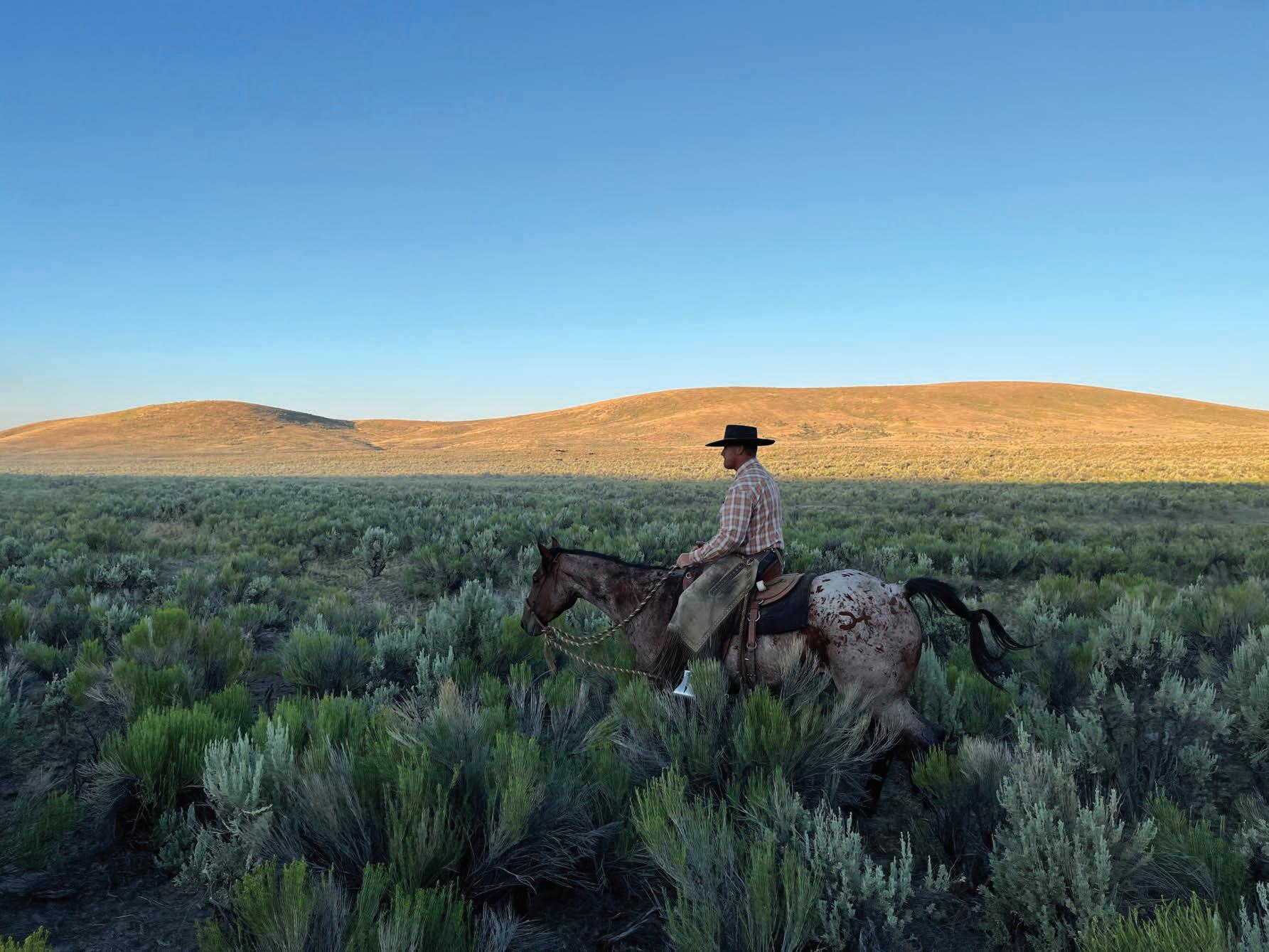

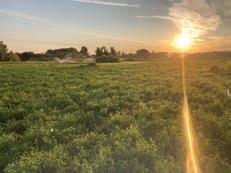



















































877-CKP-INS1 (877-257-4671) ckpin surance.com Le t CKP H elp You Pro t ec t Your P RF & LRP so you : • Protect your land and livelihood against potential losses due to lack of rainfall • Make the most informed decision for your business • Never purchase unnecessary coverage and pay more than you need Red uce ri s k a nd pro t ec t yo u r o p er a tion f rom the u n pr e dic ta bl e marke t s wit h Lives t ock R isk P rot ect ion (LRP)! LRP can be used as a useful tool to securing lending for your operation! It provides year-round coverage on a per-head basis and a guaranteed price with no bid/ask spread. When buying business insurance, it’s okay to have a generalist agent. When buying PRF insurance, it’s SMART to have a SPECIALIST. • Protects yo ur cash flow • N o claim forms for PRF • Quick & easy cla im payments • No adjusters required Protect Your PRF and LRP m (Pasture, Rangeland, Forage & Livestock Risk Protection)
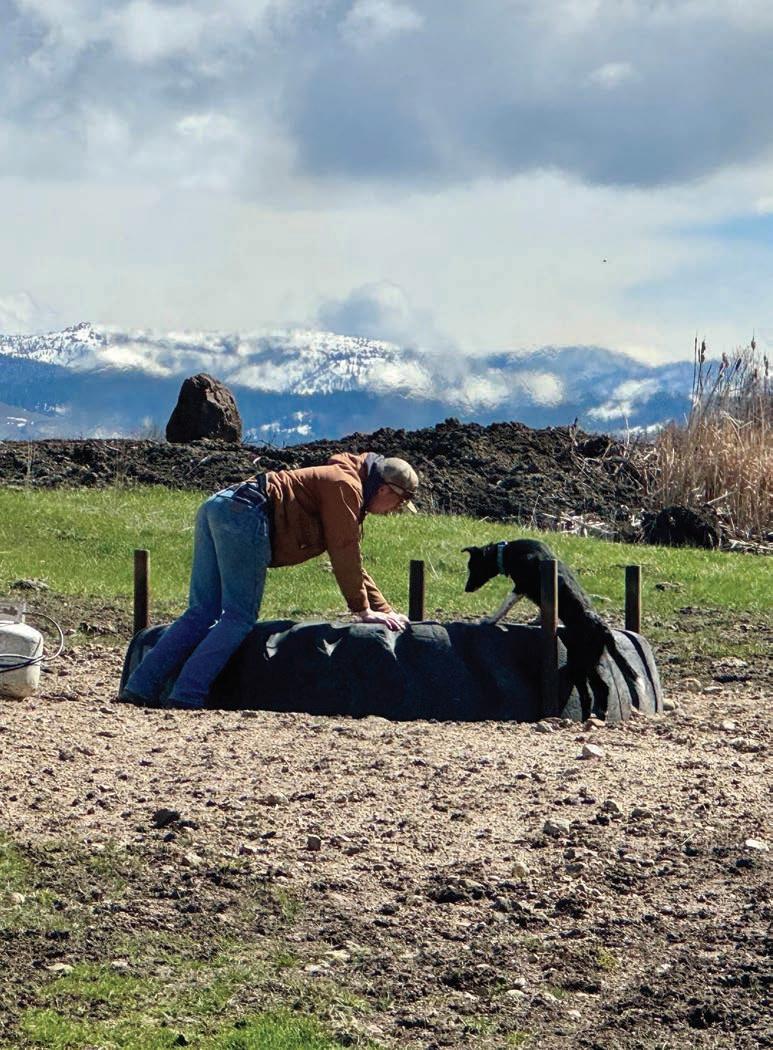
BOARD OF DIRECTORS
PRESIDENT Jerry Wroten (Wilder) 208-831-7339
PRESIDENT-ELECT
Spencer Black (Almo) 208-647-8130
VICE PRESIDENT
Val Carter (Pingree) 208-390-4811
PAST PRESIDENT
Kim Burton Brackett (Kimberly) 208-308-1952
TREASURER
Cody Hendrix (Rigby) 208-360-9693
FEEDER COUNCIL CHAIR
Shawna Gill (Grandview) 208-850-9076
PUREBRED COUNCIL CHAIR
Arnold Callison (Blackfoot) 208-681-8441
COW-CALF COUNCIL CHAIR
Roscoe Lake (Blackfoot) 208-604-3650
CATTLEWOMEN COUNCIL CHAIR
Tay Brackett (Filer) 208-866-4967
DISTRICT 1 REPRESENTATIVES
Eric Wittman (Lapwai) 208-790-5344
Cece Baldwin (Coeur d’Alene) 208-699-6611
DISTRICT 2 REPRESENTATIVES
Lori Ireland (Mountain Home) 208-866-0112
Royce Schwenkfelder (Cambridge) 208-550-2200
DISTRICT 3 REPRESENTATIVES
Chase Lanting (Twin Falls) 208-539-4371
Jesse Human (Jerome) 208-358-1277
DISTRICT 4 REPRESENTATIVES
Shane Rosenkrance (Mackay) 208-589-3110
Chris Kirby (Salmon) 208-223-2258
DISTRICT 5 REPRESENTATIVES
Matt Thomson (Blackfoot) 208-589-6901
Tim Munns (Snowville) 435-279-4420
ALLIED INDUSTRY REPRESENTATIVE
Kody Dee Williams.....(Fruitland) 509-948-6430
DIRECTORS AT LARGE
Casey Scott...............(Clarkston) 208-431-3024
CATTLEWOMEN BOARD REPRESENTATIVE
Christie Prescott (Filer) 208-420-3548
ADMINISTRATIVE STAFF
EXECUTIVE VICE PRESIDENT
Cameron Mulrony cameron@idahocattle.org
DIRECTOR OF COMMUNICATIONS & INDUSTRY RELATIONS
Morgan Lutgen morgan@idahocattle.org
ADMINISTRATIVE ASSISTANT
Michelle Johnson michelle@idahocattle.org
NATURAL RESOURCES POLICY DIRECTOR
Karen Williams karen@idahocattle.org
Contact Idaho Cattle Association: Mailing address: P.O. Box 15397, Boise, ID 83715
Location: 2120 Airport Way, Boise, ID 83705 Phone: 208-343-1615
For advertising sales, contact: idahocattlepublications@gmail.com
The Line Rider is the official publication of the Idaho Cattle Association. It is published 10 times each year, in January, February, March, April/May, June, July/August, September, October, November and December.
4 LINE RIDER JUNE 2024 www.idahocattle.org TABLE OF CONTENTS JUNE 2024 DEPARTMENTS Message from the President 6 Message from the EVP 8 Allied Industries Message 10 Message from Natural Resources Policy Director 12 Guest Column: Protect Idaho’s Public Lands 23 FEATURES Cover Story: We’ve Got a Friend in You! 14 Idaho Beef Council: Celebrating Idaho Beef Month 17 U of I: How Are Your Cows Adapting To Your Grazing System? 20 Northwest Rangeland Trust: Planning For the Future 25 ICA-IWJV Partnership Seeks to Bolster Landowner Access to Conservation Tools 28 Allied Industries Issue
Photo by Royce Schwenkfelder
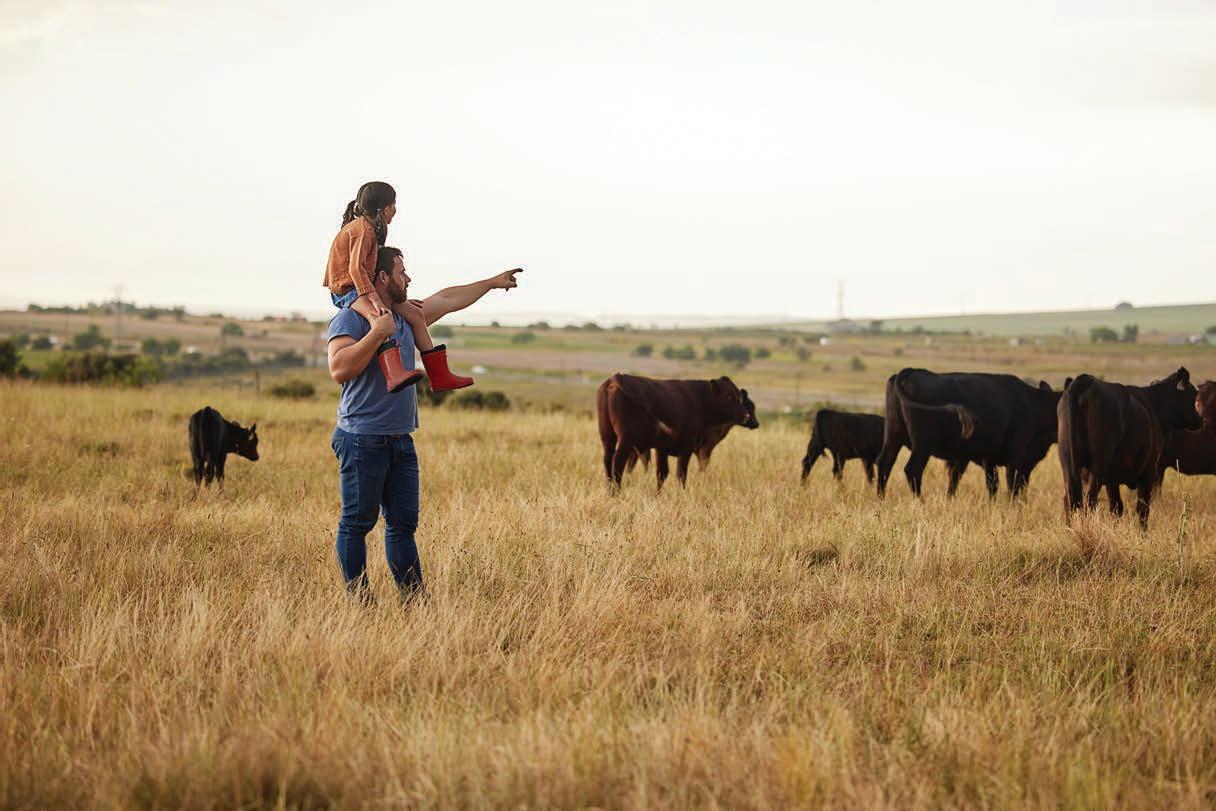



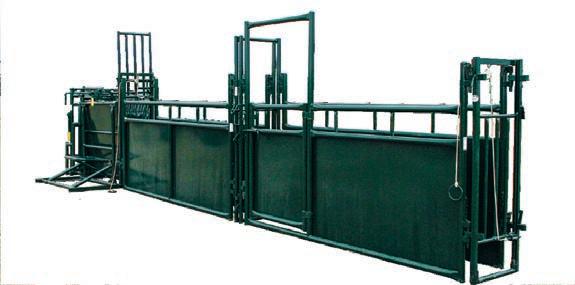
www.idahocattle.org IDAHO CATTLE ASSOCIATION 5 GROWING HERDS & RELATIONSHIPS SINCE 1904. Ag is our business. RIO HONDO Livestock Supply Squeeze Chutes - Double and S-Alleys - Calf Alleys and Tables Contact Richard Brook @ 208.308.8912 19645 Hwy 30, Buhl, Idaho www.hi-hog.com
Creating valuable partnerships
Achieving mutual success through partnership
I“ We need to continue to support our local business and encourage the next generations to explore opportunities in these fields that support agriculture.
f you want to be successful, it’s just this simple. Know what you are doing. Love what you are doing. And believe in what you are doing.”
–Will Rogers
One of joys of the lifestyle we have is sharing our experiences with family, friends, and neighbors. They all have grown up in our way of life and we have formed a western culture that is envied, and at times, even revered around the world. Some could say a lot of success is driven by the efforts you make coupled with those you surround yourself with. I would add to that group to include our fine allied industry partners from suppliers to veterinarians, and even bankers. These are the people who choose to work with us everyday, helping us make our industry a success. It’s just that simple; we know what we are doing, and our Allied Industry believes in what we are doing.
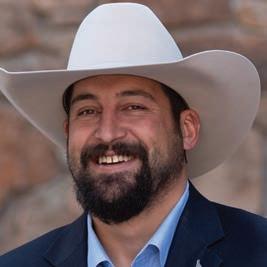 BY JERRY WROTEN ICA President
BY JERRY WROTEN ICA President
tality room hosted at the Sun Valley Resort by our Allied Industry members. I have really enjoyed both the food and the opportunity to network with industry members. Another strength of having our allied industry involved is the connections you can make. Through my tenure on the board, I have been able to meet nutritionists, equipment manufacturers, sales representatives from all over the world, and even financial personnel that seem to multiply on a good a cattle market year. I encourage our members to get to know the supporters of our industry through the Annual Resource Guide provided by ICA, as well as through engagement at our our ICA meetings.
As an operator that works to keep it simple, while believing in what you are doing, you are taking care of your cattle and operation. I would venture to estimate that others included in your success equation would possibly include a veterinarian, insurance agent, and banker, at a minimum. Maybe even a mechanic (we love mechanics), nutritionist, fertilizer salesmen, rangeland expert, wildlife biologist and potentially even a traveling salesman who specializes in vacuums (I was there, Sarah, when you bought one). Without these important collaborators/cooperators, we would have a tough time ensuring the American consumer the best quality beef in the world. We need to continue to support our local business and encourage the next generations to explore opportunities in these fields that support agriculture. We can always use partners in the industry that have experience with our business and are willing to learn more about what we do every day.
The Idaho Cattle Association (ICA) is well known for having a strong relationship with our allied industry. Some may not know, but at our annual convention located in Sun Valley each November, the allied industry elects a member to the ICA Board of Directors. They then serve a term and contribute to the ICA work and decisions. One of my personal favorite activities is the hospi-
It’s a simple ask that we support those who support us. Our allied industry members are experts in helping us do what we love. I would encourage our future members to look at possible careers with these companies as they can provide you an opportunity to stay working in a sector that you grew up in. My hat is off to our Allied Industry and all the support you have given over the years to the ICA.
6 LINE RIDER JUNE 2024 www.idahocattle.org
MESSAGE FROM THE PRESIDENT
See details about all of the events listed here in this issue’s article.
ALL MONTH LONG BUY $10 WORTH OF BEEF AT BROULIM’S GET A FREE CHUKARS TICKET
While supplies last at Idaho Falls area locations
JULY 11
BEEF COUNTS NIGHT AT BOISE HAWKS*
BEEF NIGHT AT IDAHO FALLS CHUKARS*
JULY 13
16-20
JULY 17
BEEF NIGHT AT IDAHO FALLS CHUKARS*
SNAKE RIVER STAMPEDE
Keep an eye out for the Beef. It’s What’s For Dinner. chute gate!
JULY 27
JULY 31
NATIONAL HOT DOG DAY
BEEF NIGHT AT IDAHO FALLS CHUKARS*
BEEF COUNTS
*$4 from every ticket purchased through our link will go back to the Beef Counts program.
FOR MORE INFORMATION OR TO PURCHASE BASEBALL TICKETS VISIT IDBEEF.ORG/BEEF-MONTH



JULY
IDAHO BEEF MONTH EVENTS 2024
SCAN HERE
Unlocking opportunity
Becoming the bridge between agency and producer
As we grow and build here at the ICA, we continue to develop partnerships and working relationships with many of the agencies and allied industries that support the production of the greatest protein in the world.
In this issue, you will see an introduction to the Intermountain West Joint Venture (IWJV) outlining some of their objectives. We introduced them in a breakout session at convention in 2022 and received great feedback surrounding some of the opportunities that are available through agencies such as the Natural Resources Conservation Service (NRCS), US Fish and Wildlife Services (USFS) and others to complete projects that can benefit our membership.
Fast forward to 2024 and there are still opportunities that could be available to our members and producers that align with the NRCS and IWJV missions. This led us to a partnership to help communicate the available opportunities to cattlemen and cattlewomen.
Following the session in 2022 it was apparent, to no one’s surprise, that “We don’t know what we don’t know!” Meaning, there were many attendees at the session who left saying they did not realize the opportunity to utilize NRCS or USFWS programs was available for that type of work. The goal
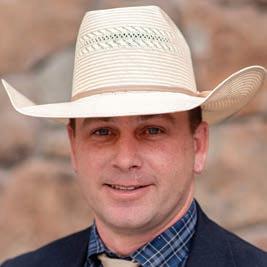 BY CAMERON MULRONY ICA Executive Vice President
BY CAMERON MULRONY ICA Executive Vice President
of our agreement is to create awareness for our producers and create opportunities for success.
The passage of the Rangeland Improvement Act in this last legislative session, (thanks to the work of past ICA president, Rep. Jerald Raymond), adds another link in the chain that we feel could provide many benefits for our industry and our operations across the state.
As we continue to build our organization, our programs, and the benefit to our membership, we see this as the start of a continuing relationship that will add value to the industry. As is sometimes said, “knowing is half the battle.”
Look to future issues of the “Line Rider”, convention opportunities in November, and other items as necessary that could create opportunity for you, your operation, and our industry.
On one final note, if you have had success or challenges with the programs that cattlemen are eligible for, please let us know so that other producers can learn from your experiences.
The ICA and Idaho’s cattle raising families are positioned to do many good things in the space of conservation, climate, etc. We need to show the reality that we are providing a positive benefit to the health of our nation; nutritionally, environmentally, and in a manner that is sustainable for the long-term.

8 LINE RIDER JUNE 2024 www.idahocattle.org
MESSAGE FROM THE EVP
vwcenergy.com





valleyag.com
shop.valleywidecoop.com
Allied assemble!
Taking ownership of your role in the preservation of Idaho’s cattle industry
Irecently read an interesting Reddit thread on what people’s interpretation of the phrase ‘Avengers assemble!’, as made by Captain America (yes, this is a boy mom activity), really meant. Was it an invitation or an instruction? Who was it directed towards? Now, while you may not be team Marvel, or even care about this genre of movies at all (it’s not something that drives my daily decisions by any means), I have to give the comic creators credit for a strong and varied cast of characters that all bind together for a common cause – saving their universe.
Our association holds special space for our Allied members in a few different ways and your participation is a vital cog in the wheel of success.
This line of thinking begs the question – what IS Allied Industries role in this beef industry universe?? Our association holds special space for our Allied members in a few different ways and your participation is a vital cog in the wheel of success. First, where do Allied Industries fit in Idaho? Years ago, the Idaho Cattle Association (ICA), was among the first states in the West to actually offer a dedicated seat for Allied Industries on our Board of Directors. This is something we still do today! The term for the Allied Industry Board Representative is 1 year, with the option to request a 1 year continuation, by vote of current members of the Allied Industries member-
 BY MORGAN LUTGEN ICA Director of Communications & Industry Relations
BY MORGAN LUTGEN ICA Director of Communications & Industry Relations
ship at Annual Convention in November. When selecting a board representative, it’s important to note that this person would be committing to attending regularly scheduled ICA board meetings, helping with sponsorship and the mid-year golf tournament at Summer Round Up, recruiting for the annual trade show, and serve as the main coordinator for all things related to the hospitality house in Sun Valley. The Allied segment of our members is unique in that they vote within the segment, which then gives direction to the Board representative in regards to voting/commenting opportunities throughout the year. Now, while Allied members don’t vote with the general membership body at our annual meeting, don’t think this makes your voice any less important. I’ve found that a good deal of our Allied members utilize their membership as an opportunity to support the industry through the company they represent, but may additionally hold a personal membership in order to participate in member resolutions. However you slice it, it’s important that the Board representative be someone that can pledge their active participation, engagement with the Allied segment as a whole and be able to confidently take those concerns or opinions to the board table.
Which brings me to the 2nd question – why should I be an Allied member instead of just a cow-calf (or other member)? Allied members are termed on an official level as those who do business on a bigger scale than just your local, one location small business owner. When reps cross state lines, cover districts/regions, or a business has 2+ locations, these are examples of what falls into an Allied membership. Our current member rate is just $225 for an annual membership and ICA makes it a priority to offer exposure opportunities that are
10 LINE RIDER JUNE 2024 www.idahocattle.org
ALLIED INDUSTRIES MESSAGE

unique to or first released to Allied members. ICA’s members span the state of Idaho and our producers have a history of doing business with others who support ICA. Your brand gets visibility in front of actual customers through multiple channels of exposure, including but not limited to, discounted ads in Line Rider, recognition of Sponsors in event programming, and our annual Resource Guide which is distributed directly to producers across the state of Idaho. ICA offers one of the largest cattle association tradeshows at our annual convention and Allied Industries receive first notification of this participation opportunity, as well as sponsorship opportunities at that event, Summer Round Up, Grass Futurity and others that may come up during the year. If your customers are in the Idaho Cattle Business, your place is in Allied Industries!
While we take a lot of pride in our offering to Allied membership in the past and currently, we’re lightly reworking a couple of aspects to make this benefit even greater to this segment of members. Beginning in 2025, Allied industries will be the only business membership level to receive a complimentary listing in the Annual Resource Guide. Additionally, it’s been several years since Line Rider advertisers have seen an increase in ad rates, but we have to keep up with the cost of doing business which means late this summer we’ll be implementing new pricing. However, until August, we’ll be utilizing our existing pricing, which means if you lock in an annual rate, it will continue through the duration of your term and you won’t see those increased costs until your next renewal. Now is the time to get into Line Rider! ICA saw an over 20% increase in number of members last year, so your dollar has a further reach at the old rates.
It’s my hope that we can continue to grow our benefits offered to ICA members. There are lots of benefit styles out there, and personally I’d like to grow our ‘book’ of tangible benefits. Do you have a business where you can offer ICA members an exclusive discount or option just for being a member? Please give me a call and share your idea! I’ve seen everything from dealership discounts to group insurance to free bottle of vaccine and everything in between, so let me know if you have an idea on where we can partner to strengthen our member benefits and hopefully support you as an ICA Allied Industry business.
The last thing I want to touch on is the benefit of active engagement. We know that there are business benefits to being visible to a membership base or advertising & sponsoring. But that’s not all that our association needs to be successful in our mission to ‘Preserve, Promote and Protect our industry. We need conversations and networks and suggestions that come from the ‘boots on the ground’ about where we can be impactful or where opportunities lie. This network not only provides a place to connect with like-minded peers or professionals, but can also lend itself to further collaboration that we want to continue to foster amongst our agency partners and the consumer community. Our beef industry universe needs ALL of you. I hope you’ll consider this invitation to hop off the fence and fully join into the Allied Industry community so we can help save the (beef) universe!
77.38+/-ACRES– -HWY 20 Bellevue- $851,000
892.86 +/- ACRES –Weiser- $1,399,000 *SOLD*
141.19 +/- Acres-Farm with 140.58+- TFCC water. Filer- $1,250,000 *SOLD*
86.16 +/- Acres– 1022 CAFO/Feedlot Buhl- $1,980,000 *PENDING*
716.01 +/- Acres– Farm w/IDWR water and 8 pivots Hazelton- $7,400,000 *NEW PRICE*
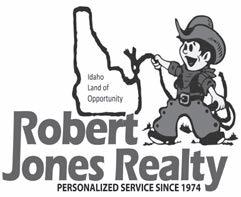
www.idahocattle.org IDAHO CATTLE ASSOCIATION 11
We Specialize in Tax Deferred Exchanges - Accredited Land Consultant
Photo by Pat Loika
Your voice amplified
Out and about with ICA leadership in Washington D.C.
If you follow the news related to happenings in Washington D.C. like I do, you probably feel a sense of frustration at the lack of any meaningful progress in the business of running the government. In the face of this inaction, ICA staff and leadership recently travelled to Washington D.C. in an attempt to bring a dose of common sense to key decision makers and spur movement on key issues impacting Idaho’s cattle industry. This annual trip is scheduled to coincide with an industry-wide Public Lands Council (PLC) and National Cattlemen’s Beef Association (NCBA) gatherings, which we attend. However, we focus the bulk of our time and effort in the nation’s capital in our own scheduled meetings with our congressional delegation and agency leaders. These meetings are focused on bringing attention and change to those things that are most impacting Idahoans’ ability to raise cattle.
The meetings with our congressional delegation are always a welcome gathering with like-minded individuals who respect our industry.
One of our key agency meetings was with USDA’s Animal Plant Health Inspection Service (APHIS) where we sat down with Dr. Mike Watson, the APHIS administrator and Janet Bucknall, the deputy administrator over Wildlife Services, along with several key members of their staff. The timing of our trip fell shortly after the discovery of Highly Pathogenic Avian Influenza (HPAI) in a dairy herd in Idaho. We were able to
 BY KAREN WILLIAMS ICA Natural Resources Policy Director
BY KAREN WILLIAMS ICA Natural Resources Policy Director
provide real-time examples of the need for improved communication from the federal government to the states in the event of a livestock disease outbreak. We were also able to learn key details about the disease’s origin and spread to cattle. In that same meeting, we also spent a significant amount of time discussing Wildlife Services, which is a division of APHIS. Wildlife Services is an invaluable agency to Idaho livestock producers in their efforts to prevent predation on livestock and control other wildlife species that pose a threat to livestock. However, reduced resources have caused the agency to be more reactive than proactive at times and has limited the timeliness and staff availability for wolf depredation confirmations. We also asked for the agency to pursue research into the issue of myopathy that causes cattle to die after being chased by predators, yet shows no outward physical signs.
On the USDA side, we also met with another key agency, Farm Service Agency. This gathering included Zach Ducheneaux, FSA administrator and about a dozen of his top FSA staff. In this meeting, we underscored the importance of strong leadership at the state level. Although a new state director has very recently been appointed, we have been without leadership in our state for a few years. It is important that the state director reconvenes the state committee, as they have an important role in overseeing the distribution of needed programs. In addition to other programs useful to livestock producers, we discussed the Livestock Indemnity Program (LIP) and asked that those program funds be available for providing help and compensation for producers faced with wolf and grizzly bear depredation on livestock. This is the second time we have met with Mr. Ducheneaux and we have found him to be an extremely down-to-earth bureaucrat . He has told us on more than one occasion that if producers have a problem,
12 LINE RIDER JUNE 2024 www.idahocattle.org
MESSAGE FROM NATURAL RESOURCES POLICY DIRECTOR
give them his direct number and he will assist them. The most astonishing thing is that he really means it. So, if you have an issue with an FSA program or a question about its implementation, let us know and we’ll put you in touch with the guy on top.
A trip to Washington would not be complete without gracing the halls of the U.S. Department of Interior (DOI) with our presence. Given the barrage of regulatory action coming from DOI, we certainly had a lot to talk about. Whether or not those messages fell on deaf ears remains to be seen. We met with DOI Associate Deputy Secretary Sarah Greenberger to present our list of concerns regarding, among other things, BLM’s Conservation and Landscape Health Rule and their push to develop renewable energy projects on federal land, especially in light of DOI’s programmatic EIS for solar energy development. We also discussed the tremendous backlog of infrastructure maintenance and development that needs to be done on BLM land. With the influx of funding in the recent infrastructure bill passed by Congress, it has been frustrating to see existing roads and infrastructure in such disrepair. This is especially pressing in Idaho as we have been facing an exponential increase in recreation on public lands and related strain on resources. Lastly, a meeting at DOI would not be complete without a dialogue about sage grouse management. As BLM moves to finalize their draft sage grouse management plan soon, following the June 13 public comment deadline, it is important that they acknowledge that grazing is beneficial to sage grouse and that restrictions on grazing are unnecessary and detrimental.
could limit their implementation. As proof of the value of our efforts to travel to Washington D.C., Senator Risch and his staff took particular note of our concerns with the BLM’s push for utility-scale solar development. The senator was not previously aware of this issue, but after expressing our concerns, he followed up the next week by organizing a coalition of senators who sent a letter to BLM Director Tracy Stone-Manning. This letter asked for a more in-depth public review of their programmatic solar plan and cautioning the agency against instituting any projects that put other multiple uses at risk.
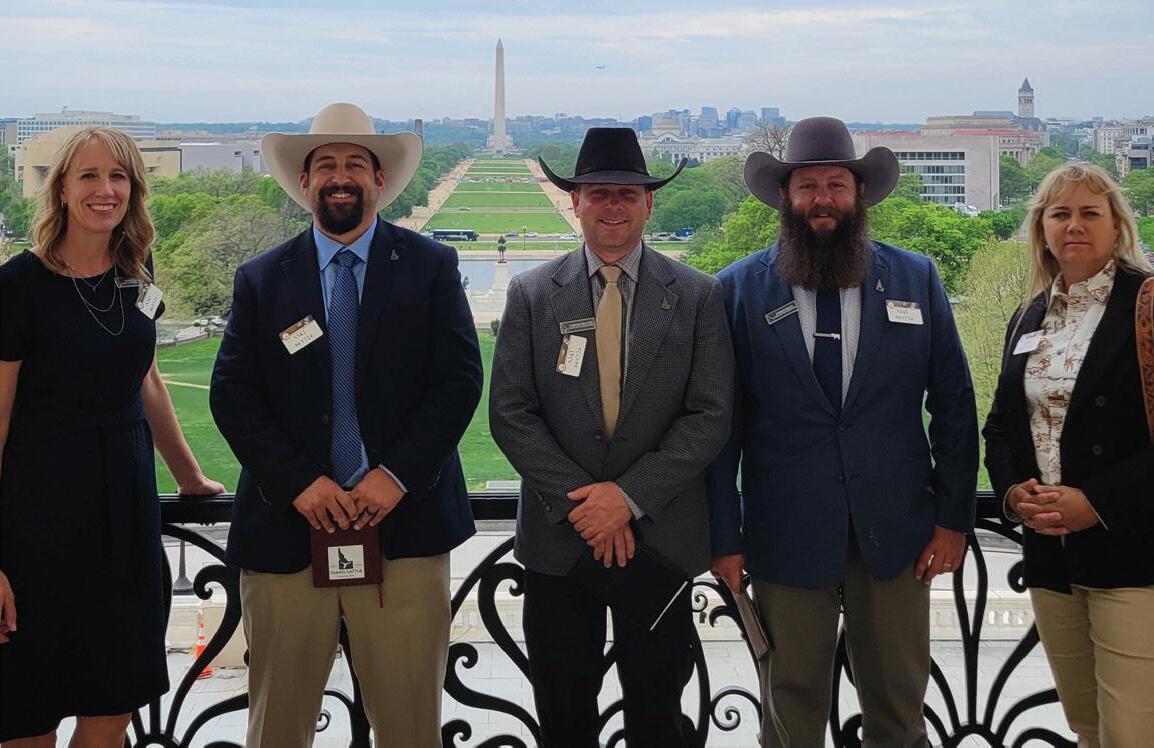
The meetings with our congressional delegation are always a welcome gathering with like-minded individuals who respect our industry, have a desire to protect it, and are well-positioned on congressional committees pertinent to cattlemen. Such is the case with Idaho’s current congressional delegation. It is always interesting to compare notes at the end of the day with our counterparts from other states who often cannot even get in the door of their senators and representatives, let alone find agreement on efforts that will assist our industry. At our meetings with Senator Risch, Senator Crapo, Representative Simpson, and Representative Fulcher and their staff, we focused on the problematic regulations coming from the Biden administration and discussed potential ways that Congress
As a slight aside to our Washington trip, I find it worth noting that in addition to the cross-country travel, I recently attended a board meeting of the Northwest Rangeland Trust (NWRT) held in Pendleton, Oregon. On my way home from the meeting, I got stuck in Oregon for several extra hours because of a bad wreck involving a massive windmill blade which shut the interstate down. The irony of this was not lost on me. One of the very things that threatens our industry is utility scale renewable energy projects on public land. The NWRT is a coalition of the Washington, Oregon, and Idaho cattle associations whose mission is providing conservation easement opportunities with the sole purpose of keeping intact working landscapes and protecting interested landowners from overzealous land trusts that would enact overly restrictive requirements on their land. (Look for more information about NWRT on page 25). This year, ICA will be further exploring easement opportunities for Idaho producers. Stay tuned for more information, as this is one tool that may be at your disposal to protect your operation from the very threats we were fighting against in Washington D.C.
Although some of our discussions may have been mildly frustrating, given the subject matter, our time in our nation’s capital was both well spent and necessary in informing key decision makers of their actions’ impact on both livelihoods of Idaho’s cattle producers and on Idaho’s landscape. As always, we will continue to forge ahead in representing Idaho cattlemen and women on issues of importance and will continue to lead the charge against any effort that could undermine your ability to raise cattle and pursue your way of life. If you have any questions about these meetings or the issues we discussed, please feel free to reach out to me at karen@idahocattle.org anytime.
www.idahocattle.org IDAHO CATTLE ASSOCIATION 13
(L-R) KAREN WILLIAMS, JERRY WROTEN, CAMERON MULRONY, SPENCER BLACK AND SHAWNA GILL POSE WITH A BACKDROP OF THE WASHINGTON MONMUMENT.
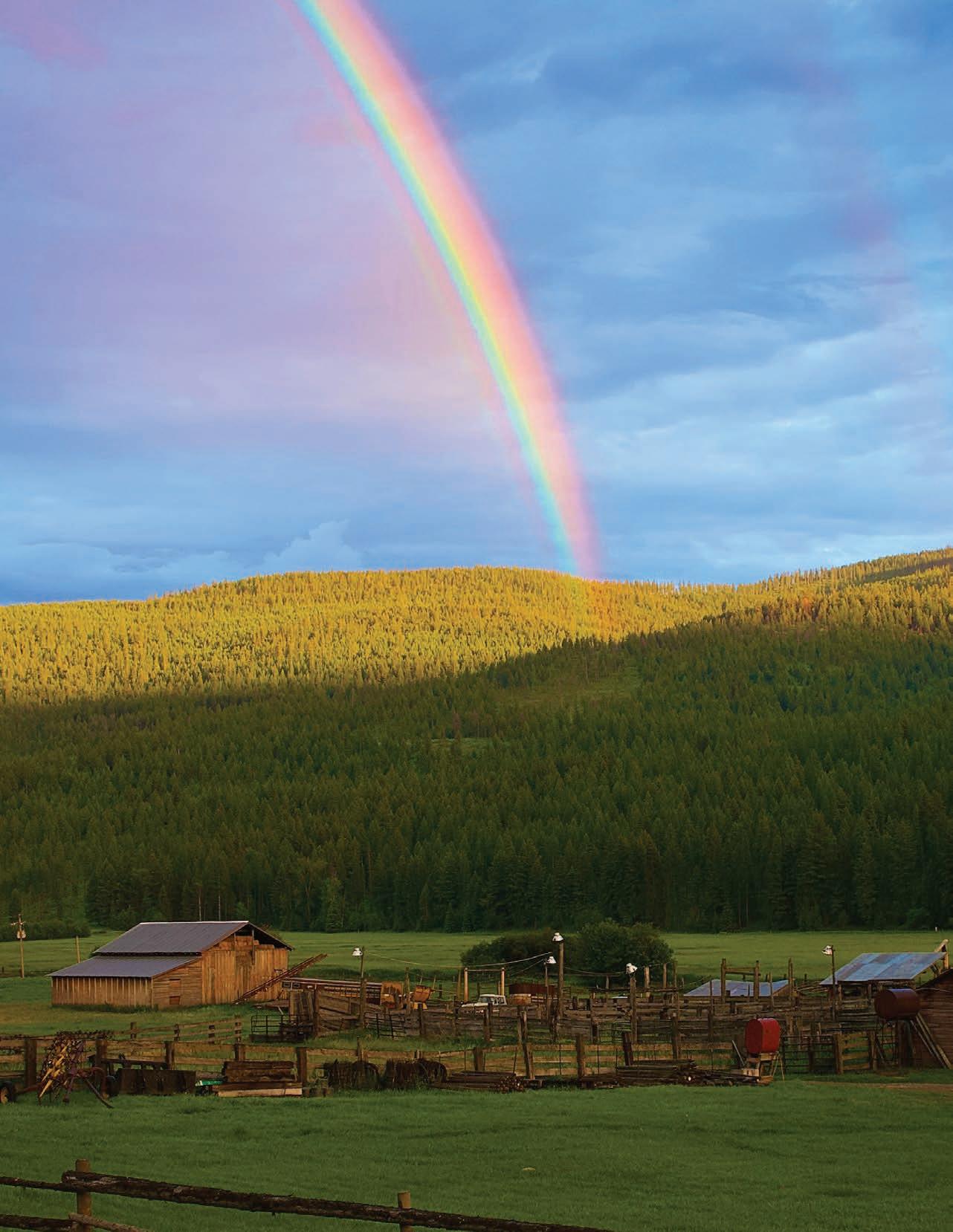 BY MORGAN LUTGEN Director of Communications & Industry Relations
BY MORGAN LUTGEN Director of Communications & Industry Relations
We’vegota FRIEND inyou!
Have you ever thought about why Allied Industries is called such? It’s a relatively accepted term in every region, but the term ‘Allied’ is used across a variety of industries and in a general sense. We are taught in school that our ‘allies’ are the ‘friends’ in the story - and this much is true when referring to the Allied Industries members of ICA. Our ‘friends’ of the industry, that offer support, services and an alliance for the beef producers of Idaho! In this issue, rather than highlighting one key player or singular focus, we opened up the opportunity for our Allied Industries partners to share a little about themselves to include in this collaboration piece. We hope you enjoy the chance to get to know some new faces, or more about someone you’ve only heard of. Thank you Allied Industries for your unwavering support of Idaho’s beef industry!
COVER STORY
14 LINE RIDER JUNE 2024 www.idahocattle.org
ERIC DREES
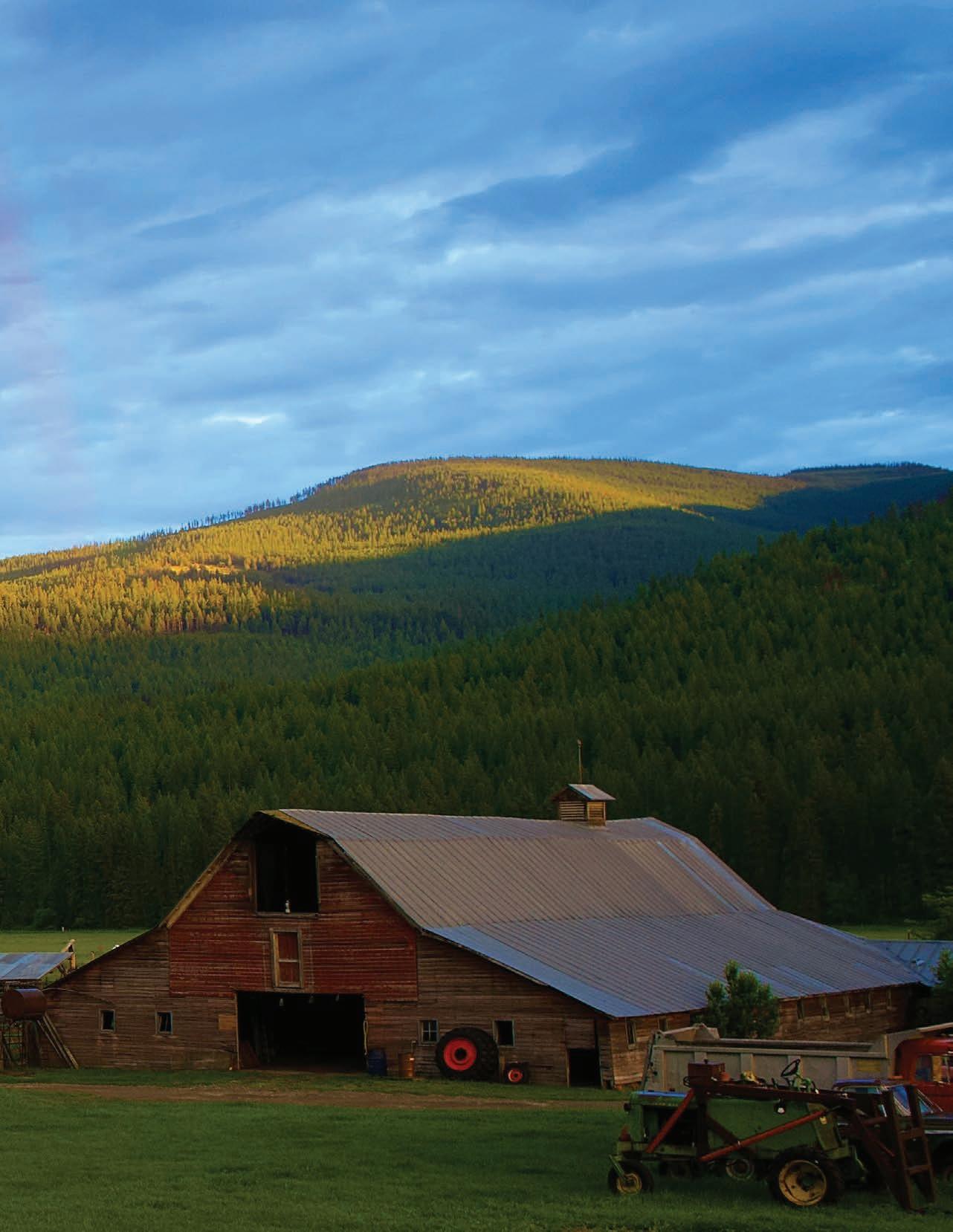

I am a livestock auctioneer and broker based in Caldwell. I sell several feeder cattle auctions and purebred cattle auctions throughout the Western US. My business also includes marketing cattle with Superior Livestock Auction as well as cattle feeding and order buying. I enjoy being a member of the ICA because of my family’s cattle business heritage here in the State of Idaho and the many friendships I have made throughout the years. A tip of the hat to ICA for the excellent job they do in representing our industry.
MERCK - GENE KLAFT

I’ve been with Merck Animal Health going on 13 years. Merck Animal Health is a great company to work for because we are always looking to develop solutions to help cattle producers solve problems, meet their goals, and produce a quality, safe, and wholesome product in a sustainable way. Being part of a larger science-based company like Merck gives us the resources to research and develop products that can help today’s beef industry in ways such as improving efficiency, better disease prevention and treatment, and introducing new technologies to make the job easier.
As a member of ICA for 15 years, I’ve enjoyed interacting with Idaho cattle producers and see the value of an organization that works hard to support their members in many ways. Being an Allied Industries member allows me and my colleagues to help with that support as well as give back to the cattle raising community.
NW MIXER FEEDERS

NW Mixer Feeders is a proud partner of the ICA to show our support to our customers as well as the agricultural industry. We are your number one source for cattle feeding equipment. We sell new and used bale feeders, feed mixers, manure spreaders, silage trailers, hay forks, heavy duty box blades and many more. If you have an idea we can build it. We have a large service fleet that is constantly out in the field
servicing that equipment that isn’t always road worthy. Give us a call today 208-459-2750 or visit our website for current inventory www.nwmixerfeeders.com. We sell the best and service the rest!
ZIONS BANK
Zions Bank, a division of Zions Bancorporation, N.A. Member FDIC, operates 121 branches throughout Idaho, Utah, and Wyoming and has a rich history of serving farmers and ranchers across the Intermountain West. We are proud members of the Idaho Cattle Association because we support Idaho’s beef industry and want to create an environment where farmers and ranchers can thrive. Our agricultural relationship managers have the expertise to help ICA members achieve their financial goals.
As a full-service community bank, Zions Bank offers lines of credit and equipment financing as well as traditional banking programs such as checking and savings accounts and mortgage loans. Founded in 1873, Zions Bank has been serving the communities of the Intermountain West for more than 150 years.
TOP NOTCH FEED AND FENCE SUPPLY: YOUR PREMIER PARTNER IN CUSTOM SOLUTIONS
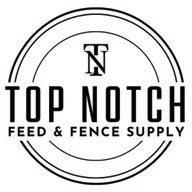
Top Notch Feed and Fence Supply, nestled in the heart of Payette, Idaho, stands tall as the epitome of craftsmanship in custom fencing, barns, gates & more. Our expertise spans across commercial, residential, and agricultural sectors, crafting tailored solutions to meet every need.
From intricate welding to sturdy structures, our team excels in building custom barns, stalls, and more, enhancing the beauty and functionality of properties across the Northwest. As Idaho’s foremost supplier of high-quality animal feed, we also ensure that every animal receives top-notch nutrition.
Participating in the Idaho Cattlemen’s Association isn’t just about business; it’s about community and camaraderie. By engaging with the ICA, we stay informed of industry trends, connect with fellow agricultural minds, and contribute to the community. Together, we’re proud to serve and elevate the standards of excellence in the livestock industry.
AMALGAMATED SUGAR – BURKE HIGLEY

Growing up, some of my fondest memories are feeding cattle beet pulp with my grandpa, Wally Higley. Amalgamated Sugar’s feed products – pressed pulp, molasses, CSB, and dried pellets – are staples of the industry. Whether you’re raising cow-calf pairs, backgrounding, or finishing cattle, chances are one of Amalgamated Sugar’s products is in your ration. That’s why it was an easy decision to become an Allied member of the Idaho Cattle Association (ICA). We want to stay involved and understand the challenges producers face. In Idaho, the fight for agriculture is ongoing, and ICA works tirelessly behind the scenes, keeping us informed so we can all advocate for the industry. Thank you for your support of our feed products!
Y-TEX
Y-TEX Corporation is dedicated to the livestock industry. Manufacturing and selling livestock identification, pest control and equine products throughout the United States and internationally. Y-TEX is proudly family owned and operated in the USA.
ICA membership is important to Y-TEX because it helps us maintain a connection to the cattle industry and the cattle producers that use our products. Contact www.y-tex.com for more information.
LEWISTON LIVESTOCK MARKET
Lewiston Livestock was built and established by Vade Spencer in 1961. In 1982, Doug Bickford purchased Twin City Sales Yard. After the purchase, Doug merged the two saleyards and almost 70 years later, the stock yard is still locally owned and operated.

LLM enjoys being apart of ICA as it allows us to stay up to date with the news and events regarding the cattle industry in Idaho.
NUTRA-LIX

What we like to call Nutra-Lix Country follows the four seasons most commonly known as winter, spring, summer and fall, but from where we stand there are four feeding seasons. Wintering, Calving, Breed Back, and Weaning. Our goal is to provide feeding solutions for ranchers in all four of the feeding seasons delivering whole herd health and a greater return on their investment.
As an independently owned business, customers can call the office and talk to a real person that manufactures and markets our premium products. From our beef liquid supplement to our Nutra-Lix Plus for horses, each product we offer is designed to maximize the utilization of the rancher’s homegrown forage. Our specialty is performance driven feed supplements for all manner of livestock using university research and ranch testing.
For 37 years, Nutra-Lix is at Home on Your Range! We in

Since the merger, Lewiston Livestock Market con tinues to succeed in getting top market prices with the most take home dollars. For over 60 years, Lewiston Livestock Market has been operated by a staff who be lieves hard work, integrity, and hospitality are a way of life; making Lewiston Livestock Market the top choice of many ranchers and farmers with in 200 miles of Lewiston, Idaho. Owner Clay Bickford and John Pear son, along with staff, work hard to guarantee customer satisfaction.
Keeping Idaho farms safe and productive since 1968. Our employee owners are dedicated to ensuring you get the best tires and auto service.
WE PROUDLY SUPPORT





Celebrating Idaho Beef Month
Fueling demand for quality beef.
As the summer hits full swing, it brings more than just a change in the weather — it also marks the start of Idaho Beef Month. Beyond the barbecue smoke and sizzling steaks, July’s month-long celebration is a time to honor the dedication and passion of Idaho’s beef industry. Throughout the month, the Idaho Beef Council, along with industry partners, are planning a variety of events and activities to promote trust and demand for beef.
For 23 years, the Governor of Idaho has proclaimed July as Idaho Beef Month. This year Governor Brad Little, will recognize not only the industry’s contributions to Idaho’s economy but also the unwavering dedication to maintaining demand for beef. With approximately 2.5 million head of cattle valued at $1.75 billion, the cattle industry is a driving force behind Idaho’s thriving agricultural sector.
Governor Little’s proclamation will highlight the industry’s dedication to the health of our communities through a variety of initiatives, including the Beef Counts program. By ensuring that all food-insecure Idahoans have access to nutritious beef, we’re not just feeding mouths; we’re nourishing bodies and fostering a sense of community. Throughout the month, there will be several opportunities to support Beef Counts while enjoying family-friendly activities.
IDAHO BEEF MONTH EVENTS
Boise Hawks Beef Counts Nights (July 11 and 31) –Treasure Valley-based baseball fans can give back by purchasing game tickets through links on the IBC Beef Month webpage;
$4 from each ticket purchased through the link will benefit the Beef Counts program. The Boise Hawks games that are valid for this promotion will be taking place on July 11th and July 31st. Follow along on Instagram and Facebook and watch for links to tickets once they are released.

Idaho
Falls
Chukars
Beef Nights (July 11, 13, 27) –
The fans located in Idaho Falls and surrounding areas will have the same opportunity for games taking place July 11th, 13th, and 27th. Four dollars from each ticket purchased through a special link on the IBC Beef Month webpage will benefit the Beef Counts program. Additionally, the Chukars will donate $2 of
www.idahocattle.org IDAHO CATTLE ASSOCIATION 17
IDAHO BEEF COUNCIL
HERBIE THE HAMBURGER AND HUMPHREY THE HAWK ARE GETTING READY TO RACE AT THE BOISE HAWKS BASEBALL GAME.
LOOK FOR THE BEEF. IT’S WHAT’S FOR DINNER CHUTE AT THE SNAKE RIVER STAMPEDE.
every hamburger sold during those games to Beef Counts. Follow along on Instagram and Facebook and watch for links to tickets once they are released or stop by Broulim’s grocery stores to pick up a free ticket when you purchase $10 of beef (maximum two tickets per person while supplies last).

National Hot Dog Day (July 17) – A favorite for all ages, the beef hot dog is a symbol of summer, from campsites to ballparks. And when it comes to customizing – the options are endless. Find inspiration by visiting the National Hot Dog Day page at www.IDBeef.org.
Snake River Stampede (July 16 – 20) -- Once again, the Idaho Beef Council is a sponsor of the Snake River Stampede, one of the most popular professional rodeos in Idaho. Look for the Beef It’s What’s for Dinner chute gate and other signage throughout the arena.
Beef Quality Assurance Certifications. Did you know that BQA helps beef producers capture more value from their market cattle? It also reflects a positive public image and instills consumer confidence in the beef industry. Are you due to renew your certification? You can do so online and it is FREE! Visit the BQA page on the Idaho Beef Council website and learn more about how to sign up today.
As Idaho Beef Month unfolds, we hope you will join us in celebrating the deliciousness of beef and the hard work and dedication of those who bring it to our plates. Let’s raise our forks in appreciation of Idaho’s beef producers, knowing that behind each mouthful lies a legacy of passion, pride, and the unmistakable spirit of Idaho beef.
For more information about Idaho Beef Month events please visit www. IDBeef.org.
18 LINE RIDER JUNE 2024 www.idahocattle.org
THE AUTHORITY IN LIVESTOCK HANDLING EQUIPMENT Is Proud To Support The Idaho Cattle Association powderriver .com P: 800.453.5318 F: 801.377.6927 Now is the time to optimize nutrition and performance. Your local CowBos Dealer delivers cost-effective, labor-saving and high-quality solutions with professional service to make the most of your investment. PROTECT PROFITS 1.855.4CowBos | www.CowBos.com
SUPPORT BEEF COUNTS THROUGH TICKET SALES AT EVENTS THROUGHOUT IDAHO BEEF MONTH.
Summer Round-Up June 24-25, 2024

Lewiston, Idaho
During Summer Round-Up, you can expect to hear from NCBA, the Idaho Beef Council and other agency representatives, as well as ICA leadership. This year’s event will hit on hot topics and bring important updates that producers are looking for. While formatted a little differently than in years past, be sure to sign up for the annual Range Tour- this year we’ll visit the University of Idaho in Moscow to experience the work being carried out in the College of Agricultural and Life Sciences. Join us to tour various programs including the progress on the Meats Science Lab, the continued development of the Steer-A-Year program, as well as the additional facilities and projects that are serving to both educate the future of our industry and provide research into important beef and cattle industry topics. As always, participants in the annual Golf Tournament can expect plenty of friendly competition and networking!
MONDAY
10:00am Registration Opens
12:00pm 1:40pm 3:00pm 4:10pm 5:30pm 6:30pm

Opening Session : The Markets & Marketing
Idaho Beef Council
ICA Council Sessions (Cow-calf/Purebred, Feeder, Cattlewomen)
General Session : Both Sides of the Fence
Cattlemen's Social
Cattle Baron's Bash & Golf Calcutta
TUESDAY
8:00am 9:15am 9:15am 10:30am 12:00pm
Breakfast with NCBA/PLC Update
Education Session : Idaho State Department of Agriculture
Education Session: Idaho Public Lands
Closing Session : Policy & Election Outlook
Participants disperse to Range Tour or Golf Tournament 12:45pm 1:30pm
Range Tour Bus Departs
Golf Tournament Shotgun Start


How Are Your Cows Adapting To Your Grazing System?
Taking stock of your herd’s nutritional needs to address your grazing management.
BY JIM SPRINKLE, PH. D.
Extension Beef Specialist
University of Idaho Nancy M. Cummings Research, Extension & Education Center
Calf prices were tremendous this fall and are mind-bogglingly high this spring. So, who wouldn’t want more cows (as long as you have the feed)? Is it time to keep or buy replacement heifers? Country-wide there is little indication that heifer retention is increasing. There are very limited reports that producers are beginning to increase replacement heifer numbers regionally. However, is this the right time?
Cows that graze rugged rangeland pastures typical of much of Idaho can be described as athletes. I am sure that all of you ranchers have experienced the frustration of a particular cow that was much more athletic than you cared for on a hot summer day in July! Yet, cows adapt to a grazing environment in a variety of ways. Range livestock nutritionists like me have been attempting to unlock some of the mysteries of livestock grazing behavior for decades and we have been known to do such nerdy things as counting the number
of bites a cow takes. A fundamental principle of range livestock nutrition is the formula:
Forage intake =
Minutes grazing time x Bites x Grams Forage Day Min grazing time Bite
For example, a 1,250 lb lactating cow grazes for 10 hours and harvests native range forage at an average of 40 bites/ minute and each time she takes a bite, she consumes 0.5 grams of forage. Doing the math, we obtain the following:
600 min/d grazing X 40 bites/min X 0.5 grams = 12,000 grams forage or 12 kg or 26.5 lbs forage/day
If we multiply the energy content of the forage consumed by the total lbs of forage, we can determine how many calories the cow was able to obtain and can estimate weight loss or gain. Table 1 shows some energetic calculations for early, mid, and late-lactating cows as well as those of a dry cow in the last trimester of mid-gestation. The cow’s internal
20 LINE RIDER JUNE 2024 www.idahocattle.org
UNIVERSITY OF IDAHO
regulatory mechanisms drive her quest to acquire the energy necessary to satisfy the nutritional demands for both maintenance and production. Since it makes more sense to consider calories for free ranging beef cattle than it does to refer to total lbs. of a fed ration, Table 1 uses megacalories (Mcal) of metabolizable energy (explained more fully in the footnotes to Table 1). The numbers in Table 1 are based upon research we have done in Idaho from 20162022 and older research done in northern Montana in the late 1980’s. I did have to extrapolate some data to produce an estimated value for the bite size for drought. All values expressed in Table 1 are on a daily basis.
COW ADAPTIVE GRAZING RESPONSES
As you noticed in Table 1, cows in early lactation lost weight in both normal and drought years. This is commonplace and expected for range cattle (Figure 2). That is one reason why we plan ahead to have cattle in at least a body condition score of 5.0 at calving. Otherwise, re -
breeding would be delayed and extend beyond the yearly calving interval. As cattle are experiencing nutritional stress, they alter grazing behavior in a variety of ways. Although we might prefer for forage intake (and thus energy intake) to be at its maximum during early lactation, forage intake does not peak until mid-lactation. The gastrointestinal tract in a range cow has “plasticity” and shrinks and expands in response to nutritional demand and forage intake.
Cows may alter any or all of the following grazing behaviors (grazing time, number of grazing bites, grazing bite size, and energetic quality of the bite). Let me explain further. For example, when we turn University of Idaho cattle out on our range unit at the Rinker Rock Creek Ranch, they preferentially graze great basin wildrye. This species has a large volume of biomass and early in the season it is green and succulent. The cows can maximize their intake/bite of forage and obtain good nutritional quality. As the season progresses into late summer,
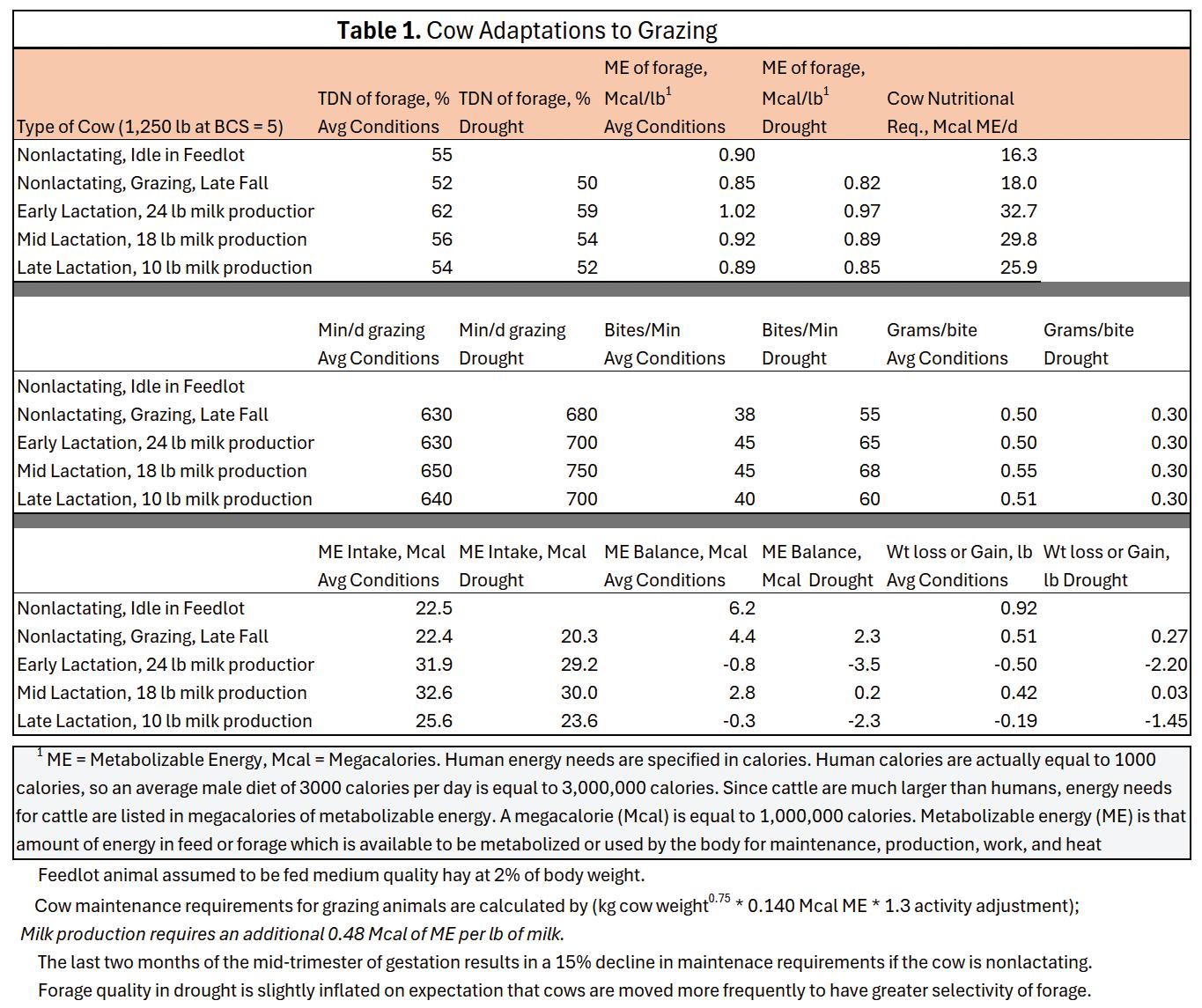
www.idahocattle.org IDAHO CATTLE ASSOCIATION 21

ENERGETIC DEMANDS, COW WEIGHT, AND MILK PRODUCTION FOR A LACTATING BEEF COW. THE NADIR IS THE LOWEST POINT OF BODY WEIGHT IN HER YEARLY PRODUCTION CYCLE. OVERLY THIN COWS WILL SUPPRESS THE ESTRUS CYCLE AND DELAY REBREEDING UNTIL AFTER PASSING THROUGH NADIR.
cattle cease to preferentially select this forage species as it matures and increases in fiber content. Cows may be lacking in nutritional wisdom, but they do know what tastes good. The things that taste good are usually green and tender, which favor increased digestibility. As cows graze a landscape, they make instantaneous decisions on which plants to graze. Unless hindered by poor forage availability, they will often sweep their heads from side to side, seeking the most prominent plants that are also greener and readily available. As forage becomes less available, cattle will increase their grazing time up to a point of fatigue which research has demonstrated to be around 12 hours/day. Cattle may meet or exceed this threshold on some days but will not generally do this for multiple days in a row. In the Montana study referred to earlier (Funston et al., 1991; Journal of Animal Science), the first year of their study in 1985 had precipitation that was 26% of normal. Cows grazed an average of 11.8 hours/day and increased their daily grazing time in late July from about 10.5 hours/day to just over 12 hours/ day in mid-September. They also increased their bite rate from just over 50 bites/minute to over 60 bites/minute in the same period. In 1986, greater precipitation resulted in more forage production and the bite rate decreased from around 65 bites/minute in early August to around 50 bites/minute in mid-September. The daily grazing time in 1986 averaged 11.3 hours/day and did not vary significantly over the course of the grazing season. In Idaho, we have found grazing times over several studies to average
around 9 to 10.5 hours per day for different cow treatment groups but with day-to-day variation being from 6 to 12.4 hours/day. Bite rates on our sagebrush steppe rangelands are typically less than for the more open rangelands of the Northern Great Plains in Montana except for late fall. On one study we did in Dubois, Idaho, we found that as the days got shorter and colder, the bite rate increased from 55 bites/minute to 85 bites/minute. Cattle were able to do this because they shifted dietary preferences to fine textured grasses (Sandberg bluegrass and annual grasses) that were more easily harvested than were larger statured dormant perennial grasses. This is further evidence for why targeted grazing in the fall is effective for reducing annual grasses.
MANAGEMENT IMPLICATIONS
But what does this all mean for livestock management? It is my hope that you won’t just see this as another epistle from someone housed in the ivory towers of academia. As Yogi Berra said, “You can observe a lot by just looking.” Here are some things you might want to watch out for:
1. Are cows lying down to rest by 9 AM? If they aren’t you may have a problem with forage supply or cows not fitting your environment (too much size and/or milk).
2. When cattle are turned out, is your range readiness such that a cow can secure a good bite of forage as she grazes?
3. Are your pasture moves timed so that cows are not searching excessively for better forage quality/quantity and extending morning and evening grazing bouts as the season progresses?
4. If cows fav or a particular forage species early in the spring, do you rotate early spring pastures to allow for species recovery?
5. When you leave a pasture does your pasture look mown or does it show some “roughness” that indicates lower utilization rates?
6. Do you plan ahead for using higher elevation pastures with more shading (trees) or temporary shade to reduce heat load during the hot season? As cows in Idaho encounter temperatures approaching 79°F, they move into mild heat load (if no breeze is blowing) and will get up later in the afternoon and spend more time lounging by water. We have found some types of cattle to be more resistant to the effects of heat load than others. Cattle that eat more than average typically also have greater heat load.
7. Do you try to use “passive” movement of livestock from one pasture to another whenever possible to reduce the energetic demands of trailing?
22 LINE RIDER JUNE 2024 www.idahocattle.org
FIGURE 2.
Protect Idaho’s public lands
Preserving the legacy of multiple-use management
Nearly two-thirds of the state of Idaho is federal land, so land management decisions made by federal agencies directly impact our state’s economy and the lives of Idahoans who live, work, and recreate on or near these federal lands. Idaho has twelve million acres of Bureau of Land Management (BLM) managed land, and our public lands provide numerous opportunities for grazing, mining, energy development, and recreation. Even before the creation of BLM, Idahoans carried out the concept of multiple and mixed uses on our lands and have done so while being responsible stewards of the land.
It’s critical that Idaho’s land remains accessible to those who have tended it for generations.
The Bureau of Land Management’s (BLM) recently finalized “Public Lands Rule” upends this nearly 50-year multiple use and sustained yield mandate while threatening the communities and industries in Idaho that rely on these lands. The rule creates a new, convoluted leasing system for “restoration and mitigation” that could effectively lock up these lands. This new mandate violates the multiple-use mandate established by the Federal Land Policy and Management Act (FLPMA) of 1976 and is a seismic shift in public land management, which has guided land management practices across the West for 50 years. This rule—enacted by the Biden administration—stands in direct conflict with the congressional mandate to manage public lands for mul -
 BY MIKE SIMPSON U.S. Congressman
BY MIKE SIMPSON U.S. Congressman
tiple uses. The proposed rule also jeopardizes years of successful management and collaboration between stakeholders who live, work, and recreate on public lands. By categorizing conservation as a use rather than an outcome, this rule will effectively ensure the uses Idahoans have traditionally enjoyed on our public lands will be placed in competition with conservation rather than in harmony.
For decades, Idahoans have cherished the concept of multiple use on public lands and have demonstrated an unwavering commitment to responsible stewardship. It’s critical that Idaho’s land remains accessible to those who have tended it for generations. I strongly believe that Idahoans are more qualified than Washington bureaucrats to determine what is best for Idaho.
Our public lands not only enrich our communities but also sustain our economy. Livestock grazing and ranching operations thrive on these lands, supporting our local economies, reducing vegetation prone to spread wildfire, and preserving the ranching traditions that are integral to Idahoans. Critical mineral production at home is fundamental to our economy and promotes our national security interests. Furthermore, outdoor recreation is a significant economic driver in the western United States, and Idaho in particular. Idahoans and visitors who make use of the state’s plentiful outdoor recreation sites add billions of dollars to the state economy and support tens of thousands of jobs.
As a lifelong Idahoan, I recognize that there are challenges facing our public lands today. That is why, throughout my time in Congress, I have regularly worked with federal land management agencies like the BLM, Forest Service, the National Park Service, and the Fish and Wildlife
www.idahocattle.org IDAHO CATTLE ASSOCIATION 23
GUEST COLUMN
Service. However, these land management agencies need to be collaborative good neighbors, and in my position as Chairman of the House Interior and Environment Appropriations Subcommittee, I am working to ensure that they act effectively and efficiently on the public’s behalf. Recently, the House considered legislation stopping this land grab. I was proud to be a cosponsor of the Western Economic Security Today (WEST) Act. The legislation will require the BLM director to permanently withdraw the rule and prevent future issuance of a substantially similar rule. On April 30th, 2024, this critical legislation passed the House of Representatives on a bipartisan basis with my support.
In my role as Chairman, I will continue to work tirelessly to defend Idaho and Western interests from efforts to impose federal mandates that would hurt our economy and way of life. Idahoans, as well as communities across the West, recognize the invaluable significance of our public lands. I strongly believe that Idahoans should have a say in how the land on which they work and live is managed, and I will continue to support any effort to overturn this overreach while continuing to advocate for a strong partnership between federal, state, and local land management agencies.
TOP NOTCH










24 LINE RIDER JUNE 2024 www.idahocattle.org
FEED & FENCE SUPPLY QUALITY SERVICERESULTS PREMIUM LIVESTOCK PRODUCTS CUSTOM FENCE & INSTALL 208 631 4904

Planning for the Future
Helping
NW ranchers ensure longterm viability of rangeland.
The Northwest Rangeland Trust (NWRT) was organized by the Oregon Cattlemen’s Association (OCA).
NWRT was incorporated as a separate 501(c)(3) corporation in 2001. Bob Skinner, NWRT Vice-President, who was the President of the OCA at the time has stated, “there were willing sellers and willing buyers for conservation easements and I felt it would be better for the landowners if they were working with an organization run by their peers.” Members of the NWRT Board of Directors must be members of the OCA, Washington Cattlemen’s Association (WCA), Idaho Cattlemen’s Association (ICA) and the majority must be producers. In 2014 members of the NWRT Board of Directors met with a delegation from the Idaho Cattlemen’s Association to discuss a formal relationship between the two organizations. Idaho Members of the NWRT Board of Directors have included Jim Little and Brenda Richards. NWRT has worked on projects in Elmore, Cassia, and Idaho Counties. Currently, there is an opening on the NWRT Board of Directors for a member from Idaho- if you’d like more information on this, please contact the Idaho Cattle Association.
NWRT is a member of the Partnership of Rangeland Trusts, a national organization made up of Land Trusts that are affiliated with or have a working agreement with their state cattlemen’s association including California,
Wyoming, Colorado, Kansas, Montana, Texas, Nebraska, South Dakota, and NWRT.
The mission of the Northwest Rangeland Trust is to help Oregon, Washington, and Idaho ranch and farm landowners protect and preserve the long-term viability of their ecologically significant private lands. The NWRT works directly with private landowners of working landscapes to ensure viability and stainability for generations to come. Additional information on the NWRT can be found at: www.nwrangelandtrust.org
So, what does that mean and how do we accomplish it? What was the driving force that necessitated the creation of NWRT:
• Many ranches and farms are being sold for purposes other than working landscapes.
• Pressure comes from investors looking for areas of development or from those who want the ground taken out of agricultural production to use it for other purposes.
• Additional pressure is created by the line of succession issues that arise when one generation wishes to retire or there is a death in the family and taxes must be paid or retirements funded.
How do we accomplish keeping privately owned ranches and farms as privately owned working landscapes? One way is with a Conservation Easement (CE). In Oregon’s case we have the most restrictive land use laws in the three states we work in. A good point is that CE provides a positive alternative to the land
www.idahocattle.org IDAHO CATTLE ASSOCIATION 25
NORTHWEST RANGELAND TRUST
use restrictions imposed by zoning. To restrict development and maintain open space zoning imposes restrictions on land use with no compensation to the landowner. CE preserve working landscapes as working landscapes and compensates the landowners for the lost value that could be gained by development.
So exactly what is a conservation easement? Simply put, a CE is a non-development agreement that protects the significant conservation elements as identified in the agreement, for compensation and/or tax benefits.
By placing a conservation easement on the property, several positive things are accomplished:
• The property is protected from development except as provided in the easement for purposes necessary for the working landscape.
• The significant conservation values are protected in perpetuity.
• The property owner receives tax incentives and/or remuneration for placing the easement on the property. In August of 2006, HR4 was passed by Congress and signed into law by President Bush. This piece of legislation significantly enhanced the tax benefits for donated or bargain sale easements for those involved in agriculture. These tax deductions were made permanent in 2015.
• Depending on the funding source, the property is monitored once per year by NWRT to ensure that the provisions of the
CE, as agreed to by the landowner, NWRT, and the funders are adhered to. This protects the Landowner and ensures that the property is used as a working landscape with best practices.
A great example of how a conservation easement can be used as a management tool for a ranch and farming operation is the Lindsay Ranch, in Morrow County, OR. The Lindsay Ranch was started back in the great depression, when the son of a Morrow County homesteader named Alex Lindsay purchased a parcel of sage brush covered with sand to run a few cows and attempted to raise some dryland wheat. Alex and his wife Rosella struggled through many tough times going seven straight years without a single crop due to dust and wind. Their only child, Larry, was an officer in the Air Force and had been a
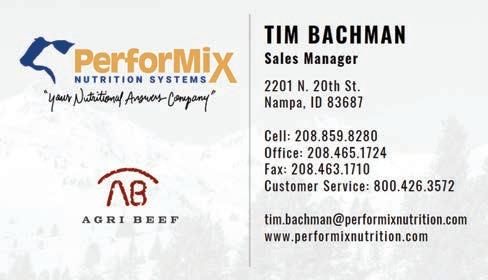

26 LINE RIDER JUNE 2024 www.idahocattle.org

valedictorian at the University of Portland. Larry had just finished his first year at Georgetown law school, where he was preparing to become an Air Force JAG officer, when his father, Alex, suddenly passed away in his sleep at the age of only forty-four. Larry, only twenty-three years old at the time, requested a military transfer back to Portland, Oregon where he could finish his military service while taking over his dad’s farm and ranch in Morrow County.
Larry soon began a long-distance relationship with a fellow valedictorian from the University of Portland named Corrine Remily (who also was a college cheerleader and accomplished dancer) who was doing scientific research in Germany under a well-known chemist. After convincing her to marry him, she joined Larry on the desert farm, and they became inseparable business partners and had nine children along the way.
Larry was a pioneer in developing irrigation from the Columbia River and was instrumental in turning the desert sand of Morrow County into some of the most productive farm ground in the world. He also served as a Port of Morrow Commissioner for over 50 years where he saw it grow from nothing to the multibillion-dollar industries it hosts today. Larry took out many loans to get irrigation water twelve miles from the river and onto his ground. He vowed he wouldn’t wear his cowboy hat again until he was out of debt. He hasn’t been able to wear his hat since, but he has been able to keep his dad’s farm going by developing a small custom feedlot back in the 1970’s to market his crops through. Larry happily turned management of the feedlot over to Corrine, which she still does to this day. Corrine began feeding with one of the first high quality Wagyu beef producers to come over from Japan. Lindsay ranch has been raising and feeding cattle for the Japanese company Super Prime Beef that is internationally renowned under its Washygu label for almost 25 years now.
but with the help of all seven of their surviving children, spouses, and grandkids, Lindsay Ranch is still operating and going strong.
Joe Lindsay stated, “Tom Price and Frank O’Leary came out to the ranch a few years back and visited with us about how NWRT advocates for farmers and cattlemen to keep the ground being used for agriculture. It wasn’t long after that I made one phone call to Frank, and he got the ball rolling for an easement for us, provided we continued to use the ground for farming and rangeland, which was our sole intent anyway. I thank God for the providential day I first met those good people and all that NWRT has done for us.”
Funding for the Lindsay project was provided by the Defense Department’s Readiness and Environmental Protection Integration program (REPI). The Navy, the Trust for Public Land, and Northwest Rangeland Trust worked with the Lindsays to establish an agricultural conservation easement on the land that limits development and keeps the property in ranching and farming in perpetuity. The easement is part of a longterm effort to maintain the Navy’s ability to conduct low altitude training for aircrew above the Naval Weapons System Training Facility by working closely with, and providing financial compensation to, the landowner.
The easement is part of a long-term effort to maintain the Navy’s ability to conduct low altitude training for aircrew above the Naval Weapons System Training Facility by working closely with, and providing financial compensation to, the landowner.
“This project is the perfect example of four entities, with diverse objectives, working together to achieve conservation goals, sustainable agricultural use and strengthen national defense,” said Frank O’Leary, Executive Director of the Northwest Rangeland Trust. “The Northwest Rangeland Trust is proud to be a contributing partner to this successful effort.”
As a project hasn’t yet been completed in Idaho, NWRT is very interested in connecting with producers who have potential products. Be sure to reach out to your staff and leaders at ICA to get linked up with someone at NWRT who can help answer those questions.
There were some hard times back in the 1980’s when the interest rates were over 18% and land had to be sold to stay afloat
For additional information about the Northwest Rangeland Trust and conservation easements please contact Frank O’Leary at 509-520-7483, or foleary7@gmail.com, or at www.nwrangelandtrust.org.
www.idahocattle.org IDAHO CATTLE ASSOCIATION 27

ICA-IWJV Partnership Seeks to Bolster Landowner Access to Conservation Tools
The Intermountain West Joint Venture (IWJV) is excited to partner with the Idaho Cattle Association to help make Natural Resources Conservation Service (NRCS) programs accessible to Idaho producers.
The IWJV is a partnership of federal, state, tribal, private, and non-governmental organizations working to conserve bird habitats in the Intermountain West region through collaborative, voluntary conservation that works for people. Its focus is threefold: wetlands and the waters that support them through its Water 4 program, sagebrush ecosystems through the Partnering to Conserve Sagebrush Rangelands program, and arid conifer forests through a new Western Forests program. These habitats collectively encompass the majority of the Intermountain West and sustain a multitude of bird species and other wildlife, as well as human communities.
Supporting its partners with science, capacity, and communications enables the IWJV to get funding and projects on the ground. The IWJV’s Science to Implementation team works to deliver science to practitioners in accessible and implementable ways, while its Communications team works to share stories of people doing successful conservation work.
Capacity initiatives, like the Sage Ca-
pacity Team, enable the IWJV to direct partner investments to field-based positions that build relationships with producers and land managers to get work done. Rancher and Idaho Rangeland Conservation Partnership coordinator Brenda Richards, is a member of the Sage Capacity Team and one of the IWJV’s Idaho State Conservation Partners. She said that one of the strengths of the IWJV is its ability to connect people to science and resources—as well as to other people.
“The IWJV’s network of partners and science and communications resources makes it an effective platform for producers to better work with agency employees and other organizations to make sure that conservation actions work for both wildlife and people,” Richards said.
The IWJV partnership is committed to working lands and the people who steward them. It also supports land management practices that sustain bird habitat in a voluntary, non-regulatory manner. Kim Brackett, an Idaho rancher and current IWJV Management Board vice-chair (as well as an ICA Executive Committee member),
said that the IWJV’s government relations work emphasizes connecting decision-makers to the people who are doing the work on the ground.
“The IWJV plays a huge role in connecting the dots between high-level policy decisions and the day-to-day challenges producers face throughout Idaho and the Intermountain West,” she said. “The IWJV partnership is an effective forum for reaching across fencelines (both metaphorical and literal) to get work done on the ground.”
In that spirit, the IWJV’s work with the Idaho Cattle Association increases capacity for connecting Idaho producers to NRCS tools and programs. The ultimate goal is a system that makes it easier for ranchers to apply conservation practices that bolster both their operations and Idaho’s wildlife.
Want to learn more about the IWJV? Start with an exciting new body of research from the IWJV and partners that shows that flood-irrigated grass hay provides critical wetland habitat in many parts of the West. Check it out at iwjv.org
28 LINE RIDER JUNE 2024 www.idahocattle.org
PARTNER SPOTLIGHT
The Bureau of Land Management (BLM) released for public review the latest version of their proposed sage grouse management plan. The implementation of this plan will greatly affect how grazing, and other uses, are managed on public land. ICA needs you to take part in this public process and let the BLM know that grazing is good for sage grouse.
To review the plan, type “BLM sage grouse plan” in your internet search browser and click on the BLM’s plan site. From there, you can follow the links to read the documents and comment.
The comment period closes on June 13. We recommend you use the following points to focus your comments. Feel free to copy these points or build from them to formulate your own comments. For more information or to review ICA’s full comments, please visit the Western Martingale, https://westernmartingale.com/greater-sage-grouse/ or email to karen@idahocattle.org.
Key Commenting Points:
• Livestock grazing is good for sage grouse and should not be reduced. It promotes healthy vegetation growth, reduces fine fuels, and helps control invasive species.
• A recent study completed by the University of Idaho has proven that grazing provides many benefits for the species. It is important to incentivize good grazing practices rather than punish or limit grazing.
• Alternative 3 is bad for sage grouse, bad for the economy, bad for cooperative conservation efforts, and contrary to the BLM ’s multiple -use mandate.
• Through its existing framework and rangeland health standards, BLM already has the adequate mechanisms in place to manage grazing in sage grouse habitat. If existing grazing management is meeting standards then sage grouse habitat is being adequately managed and conserved. There should be no additional restrictions on grazing permits.
• Unless livestock grazing has been determined as the single causal factor in habitat or population decline, livestock reduction in any form should not be considered by BLM in any management action.
• Management decisions should be made at the local level based on site -specific impacts and ecological site potential. The plan should defer to information at the local and state level and allow decisions to be made at that level that are not top-down prescriptive and responsive to what is happening on the ground.
• Rangeland improvement projects are an important tool for grazing permittees and the BLM to manage grazing at optimal levels. This plan should not result in the reduction or elimination of range improvements and should not discourage their development.
• Idaho has been a leader in collaborative sage grouse conservation efforts and Idaho ranchers have proven themselves willing and able to come to the table to reach effective solutions for management concerns. The BLM ’s plan for Idaho should mirror the collaboratively -developed state plan. Online
On the BLM’s plan website, click on the “Participate Now” button, and enter your comments through the website. E Email
blm.gov
BLM_HQ_GRSG_Planning@
M Mail BLM Utah State Office ATTN: HQ GRSG RMPA 440 West 200 South #500 Salt Lake City, UT 84101


New and renewed ICA members
Western Video Market
Larry & Nancy Fitch
Clay & Laura Pickard
Kevin McLain
Lester Barfuss
Carl Hatch
Jayson Hatch
Marianne Josephson
Brantly Hatch
John, Shawn & Chris Banks
Erma Banks
David Banks
Wayne Perkins
Grant Simons
Shryl Simons
Tony Holsten
Todd Holbrook
Cody Barfuss
Roxie Holsten
Ty Barfuss
Seth Pratt
Mark & Wendy Pratt
Stephen J. Blaser
Chet Nicholas
Dan & Lisa Stephenson
Shawn Oleson
Lake Family Ranches, Inc.
Roscoe Lake
Layne Hamilton
Rhitt Hamilton
Shane Hamilton
Art & Stacy Butler
Greg & Rita Hall
Lynn & Tiffany Bachman
Wade & Gwenna Prescott
Steve Regan Co.
Rusty Nye
Steve Runyan
Craig Simons
Keri Pardew-Peck
Cameron Williams
Crae Williams
Lee Muench
Ken, Brayden & Nathan Eliason
Matt & Sarah Thomson
Wayne & Julie Burkhardt
Sara Somsen-Fowler
Dr. Bob Monroe
Glen Christiansen
Stephen Shiner
Debbie Johnson
Matt & Denise Tubbs
Jess Showell
Broken Bar Land & Cattle
Alan Clark
Adam Clark
Roger W. Clark
John & Reta Sutton
Russ Stoddard
Ernie Robinson
Nick Colwell
Leo Baptiste
Eugene Matthews
Broden & Angie
Matthews
Scott & Eric Bedke
Phillip Obendorf
Brian Kossman
George Colwell
Muriel Judge
Karl Loveland
Clay & Victoria Davison
Jake & Samantha Brackett
Belle Brackett
Gus & Kimberly Brackett
Will Brackett
Bert & Paula Brackett
Katie Brackett
Lowell Cerise
Don Taber
Brett Barfuss
Rodney Peightal
Russell K. Boyer
Tim & Jennifer Keller
Denver Hawkes
Roy Neal
RonDell Skidmore
Vard Neal
Bodie Booth
Hal & Pam Harris
Wade Greig
Wyatt Greig
Lance Westmoreland
Ty Reeder
Ron L. Anderson
Aaron Golladay






Livestock Scales
Established in 1959, Scales NW offers a wide range of equipment, from precision lab balances to high capacity rail scales, as well as certified scale service and installation.
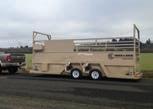


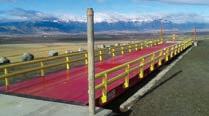
30 LINE RIDER JUNE 2024 www.idahocattle.org
MEMBERSHIP
Specializing in Truck and
Contact Steve Orr for more information today! Email: steveorr@scalesnw.com Phone: (503) 510-3540 www.scalesnw.com • (800) 451-0187 Scales NW is proud to serve: California Idaho Montana Nevada Oregon Utah Washington AD_POWELL_LivestockTruckScale_4.5x5.indd 1 12/20/2017 4:34:34 PM

EMILEE HOLT
Territory 1 Field REp.
PO BOX 151, Huston, ID 83620 (208) 965-3130 cell eholt@hereford.org


KODY DEE WILLIAMS
Northwest Regional Manager
Cell: 509.948.6430
Office: 800.989.8247
Email: kodydeewilliams@allflexusa.com




9351 Lake Shore Drive Dennis: Nampa ID 83686 (208) 989-1612 2 miles west of Hwy. 45
James & Dawn Anderson 208-280-1505 208-280-1509 Beverly Bryan
2 Year Olds & Spring Yearling Bulls Spring Yearling Hereford & Red Baldy Heifers
Check out our offering at jbbalherefords.com
JBB/AL HEREFORDS 1973 S 1500 E GOODING, ID 83330 jbbalherefords@gmail.com
P.O. Box 612266 • 2805 East 14th Street Dallas/Ft. Worth Airport, Texas 75261-2266 Dennis Boehlke
Bryan & Charly Anderson 208-280-1964 Jae Anderson
KNIPE LAND COMPANY
• Farm, Ranch, Recreation, Large Land Parcels, and High Net-Worth Real Estate • 1031 Tax Deferred Exchanges info@knipeland.com • 208-345-3163 • www.knipeland.com Our experienced sales team is ready to solve your real estate needs. Ready to buy or sell? Call today!

www.allflex.global/us/
PRIVATE
TREATY SALES HEREFORD & RED ANGUS
AMERICAN HEREFORD Association
BUILT ON TRADITION. ENGINEERED TO SUSTAIN. BREEDER & SERVICE GUIDE
Our Family Invites You to Our Fifth Annual Angus Genetics Sale in Moses Lake, Washington This Fall!










































































 BY JERRY WROTEN ICA President
BY JERRY WROTEN ICA President



 BY CAMERON MULRONY ICA Executive Vice President
BY CAMERON MULRONY ICA Executive Vice President






 BY MORGAN LUTGEN ICA Director of Communications & Industry Relations
BY MORGAN LUTGEN ICA Director of Communications & Industry Relations


 BY KAREN WILLIAMS ICA Natural Resources Policy Director
BY KAREN WILLIAMS ICA Natural Resources Policy Director

 BY MORGAN LUTGEN Director of Communications & Industry Relations
BY MORGAN LUTGEN Director of Communications & Industry Relations






















 BY MIKE SIMPSON U.S. Congressman
BY MIKE SIMPSON U.S. Congressman







































